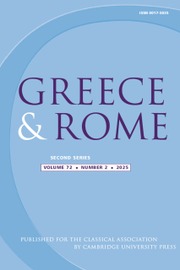Article contents
Pliny, the Man and his Letters
Published online by Cambridge University Press: 05 January 2009
Extract
Pliny lived in the heyday of the Roman empire, being born in A.d. 62 in the middle of the reign of Nero, at Comum by Lake Como in north Italy, and he lived until about A.d. 112. His family were not of the old Roman nobility but belonged to the second grade of the Roman upper classes, the so-called Knights or equites Ramani. Pliny trained to become an advocate in the courts of civil law, and partly by his talents and partly through the influence of family friends in the senatorial class he gained promotion to the senior grade of the Roman administration. He became a Roman senator when he was about twenty-eight years old, and eventually climbed to the top rung of the Roman public service. So he was in Roman terms a self-made man, the first senator of his family. But he was also a highly educated man; as a young man he attended the schools of the most famous professors of literature at Rome, and especially that of the great Quintilian, whose book on the art of rhetoric survives to show the sort of education that Pliny received.
- Type
- Research Article
- Information
- Copyright
- Copyright © The Classical Association 1969
References
page 76 note 1 For the historical background of Pliny's life and times see SirSyme, R., Tacitus (Oxford, 1958)Google Scholar, chs. iii, vii, viii; for his local setting, Chilver, G. E. F., Cisalpine Gaul, Social and Economic History (Oxford, 1941)Google Scholar, ch. vi, 2; and for the details of his career my Letters of Pliny (Oxford, 1966), 72 ffGoogle Scholar. (cited as Letters). For a shorter account, Sherwin-White, A. N., Fifty Letters of Pliny (Oxford, 1966), ix–xvGoogle Scholar. The best account of the literary life of his circle is Guillemin, A.-M., Pline et la vie littéraire de son temps (Paris, 1929)Google Scholar. The Letters and the Panegyricus are now available in O.C.T., and a modern translation in the ‘Penguin’ series by Mrs. Radice, who is shortly producing a new edition in the Loeb collection.
page 77 note 1 The character of the Letters is discussed at length in Letters, pp. 1–18.Google Scholar
page 77 note 2 My versions of Pliny's letters are throughout compressed and abbreviated translations and paraphrases, intended to reveal the character and flavour of the originals, to those for whom his qualities are still obscured by the formalities of his prose.
page 78 note 1 Pliny, , Epp. iii. 14Google Scholar. For brief commentary see my Fifty Letters, no. 14, cited hence forth as FL.
page 78 note 2 Epp. iv. 19Google Scholar (FL, no. 19).
page 79 note 1 See the account of a Roman engagement in Epp. i. 14. 8.Google Scholar
page 79 note 2 Epp. viii. 5.Google Scholar
page 79 note 3 Epp. vii. 5.Google Scholar
page 79 note 4 Epp. i. 5Google Scholar; ii. 20; iv. 2; vi. 2.
page 79 note 5 Domitian died October 96. He had persecuted senators who criticized his dictatorial methods.
page 80 note 1 From Epp. i. 5. 1, 8, 15.Google Scholar
page 80 note 2 Epp. iv. 7. 1–3.Google Scholar
page 80 note 3 Epp. vii. 24Google Scholar (FL, no. 29).
page 81 note 1 Epp. vi. 11.Google Scholar
page 81 note 2 Epp. iv. 16.Google Scholar
page 81 note 3 Epp. v. 19Google Scholar (FL, no. 24). For slaves and freedmen see Carcopino, J., Daily Life in Ancient Rome, 56 ff.Google Scholar
page 82 note 1 Epp. vii. 6 and 14.Google Scholar
page 82 note 2 Epp. viii. 6Google Scholar. Pallas held the financial secretariat (a rationibus) under the emperor Claudius A.d. 41–54. Tacitus recounts this affair in Ann. xii. 53.Google Scholar
page 82 note 3 There are two letters, Epp. vi. 16 and 20Google Scholar. Vesuvius erupted 24 August 79.
page 83 note 1 Epp. vi. 20. 13–15.Google Scholar
page 83 note 2 For a brief discussion see FL xvii.
page 83 note 3 Epp. ii. 11. 13 (FL, no. 10).Google Scholar
page 83 note 4 EPP. v, 19. 5Google Scholar; vi. 20. 17.
page 83 note 5 Quintilian discusses sententiae in Inst. viii. 5.Google Scholar
page 83 note 6 Epp. vi. 22. 8.Google Scholar
page 83 note 7 See Letters, pp. 14–16.Google Scholar
page 83 note 8 Epp. vii. 17 (FL, no. 27); vii. 21 (FL, no. 34).Google Scholar
page 84 note 1 Epp. vii. 27. 14 (FL, no. 30).Google Scholar
page 84 note 2 Epp. vii. 19.Google Scholar
page 84 note 3 Epp. iv. 11Google Scholar. See Letters ad loc. Cf. Suetonius, , Dom. 8. 4Google Scholar. The trial took place between A.d. 89 and 91.
page 85 note 1 Epp. iii. 19Google Scholar (FL, no. 16).
page 86 note 1 Epp. vii. 18Google Scholar. Similar foundations were established throughout Italy by Trajan and his successors.
page 86 note 2 Epp. ix. 37.Google Scholar
page 86 note 3 Cf. FL x–xi.Google Scholar
page 86 note 4 FL xiii–xv.Google Scholar
page 87 note 1 Epp. xGoogle Scholar, Epistulae ad Traianum, contains some forty major consultations and Trajan's replies, in addition to some minor and formal exchanges. The relative responsibility of Trajan, Pliny, and the Roman secretariat in the formulation of policy has been much discussed. See Letters, 526 ff.Google Scholar, and Millar, F., ‘Emperors at Work’, JRS (1967), 9 ff.Google Scholar
page 87 note 2 Epp. x. 31–2Google Scholar (FL, no. 41–2).
page 87 note 3 Epp. x. 96–7Google Scholar (FL, no. 47–8).
page 88 note 1 Epp. x. 33–4Google Scholar (FL, no. 43–4).
page 88 note 2 Epp. vi. 16. 5–6 (FL, no. 25).Google Scholar
page 88 note 3 Epp. v. 6. 20, 23, 36, 37, 40.Google Scholar
page 89 note 1 Epp. viii. 8Google Scholar (FL, no. 37).
page 89 note 2 Epp. iv. 30Google Scholar (FL, no. 21).
page 90 note 1 Epp. ix. 13. 10.Google Scholar
- 2
- Cited by


